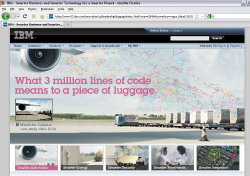A Peek at How 3 Million Lines of Code Move Luggage at Schiphol
www.ibm.com/luggage does a great job bringing automation and integration to life. It explains how “3 million lines of code” move luggage efficiently at Amsterdam’s Schiphol Airport.
 Maybe it’s because when I was growing up my Dad was a Madison Avenue advertising guy, but I’ve always had an interest in and respect for smart advertising.
Maybe it’s because when I was growing up my Dad was a Madison Avenue advertising guy, but I’ve always had an interest in and respect for smart advertising.
That’s probably why, when I saw an IBM print ad that talked about how its software was helping Amsterdam’s Schiphol Airport run more effectively, I was intrigued enough to look at www.ibm.com/luggage.
The website does a great job bringing automation and integration to life. It explains, as the headline says, “What 3 million lines of code means to a piece of luggage.”
In a 2:34 minute video, Schiphol’s Rob Holdorp explains that the airport handles about 140,000 bags a day, serving both the passengers who own those bags and the airlines who want to sell short connection times. Holdorp says that the airport moves about 50 million bags a year and that it projects growing to 70 million bags — a 40% increase.
“We have 21 kilometers of transport conveyors,” says Holdorp. “We have six robots, we have 9,000 storage capacity. All that has to be synchronized, that it works as one system.” The software, he says, is “making the system more intelligent.”
Since the footprint of the airport can’t get bigger, there’s a real challenge in thinking about expanding capcity. Hans Deijkers of IBM Global Services says in the video: “we must make more capacity available by making the system smarter.”
“Typically, a baggage system is a kind of black box,” says Deijkers. “The bag comes in, and you don’t see it any longer until it comes out. You can not track it at any point. Our smart system is the opposite. You can track an individual bag at each point in its journey.” The system chooses the fastest way to move the suitcase to its exit point.
Throughout the video, which has been viewed over 19,000 times so far, you see the guts of the airport — the behind-the-scenes part that passengers are never privy to. For anyone who travels by air, it’s a fascinating mini case study.
